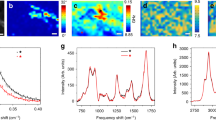Abstract
Integrating and interfacing solid mechanics and life sciences is challenging, but, with effort, the two disciplines can complement one another. This paper describes work ongoing at the Mechanical and Aerospace Engineering Department of the University of Missouri at Rolla on cellular biomechanics and mechanical characterization of single cells. Also discussed is the study of tissue biomechanics in understanding the mechanical aspects of lens accommodation in human vision.
Similar content being viewed by others
References
K. Vliet, G. Bao, and S. Suresh, “The Biomechanics Toolbox: Experimental Approaches for Living Cells and Biomolecules,” Acta Materialia, 51 (2003), pp. 2881–2905.
M. Arnoldi et al., “Bacterial Turgor Pressure Can Be Measured by Atomic Force Microscopy,” Physical Review E, 62 (1) (2000), pp. 1034–1044.
A. Boulbitch, “Deformation of the Envelope of a Spherical Gram-Negative Bacterium during the Atomic Force Microscopic Measurement,” J. Electron Microscopy, 49 (3) (2000), pp. 459–462.
X. Yao et al., “Atomic Force Microscopy and Theoretical Considerations of Surface Properties and Turgor Pressures of Bacteria,” Colloids and Surfaces B: Biointerfaces, 23 (2002), pp. 213–230.
K.-T. Wan, V. Chan, and D.A. Dillard, “Constitutive Equation for Elastic Indentation of a Thin-Walled Bio-Mimetic Microcapsule by an Atomic Force Microscope Tip,” Colloids and Surfaces B: Biointerfaces, 27 (2002). pp. 241–248.
Y. Sun et al. “Mechanical Property Characterization of the Mouse Zona Pellucida,” IEEE Transaction on NanoBio Science, 2 (4) (2003), pp. 279–286.
K.K. Liu et al., “Characterizing Capsule-Substrate Adhesion in Presence of Osmosis,” Colloids and Surfaces B. Biointerfaces, 25 (4) (2002), pp. 293–298.
K.-T. Wan and K.K. Liu, “Contact Mechanics of a Thin Walled Capsule Adhered onto a Rigid Planar Substrate,” Medical and Biological Engineering and Computing, 39 (2001), pp. 605–608.
N. Fang et al., “Colloidal Adhesion of Phospholipid Vesicles; High Resolution Reflection Interference Contrast Microscopy and Theory,” Colloids and Surfaces B: Biointerfaces, 25 (4) (2002), pp. 347–362.
Basic and Clinical Science, Course (Section 11): Lens and Cataract (San Francisco, CA: American Academy of Ophthalmology, 2004).
C.H.M. Chien, T. Huang, and R.A. Schachar, “Analysis of Human Crystalline Lens Accommodation,” J. Biomechanics, 39 (4) (2005), pp. 672–680.
Author information
Authors and Affiliations
Rights and permissions
About this article
Cite this article
Wan, Kt. Incorporating solid mechanics into biomedical and life sciences. JOM 58, 42–45 (2006). https://doi.org/10.1007/s11837-006-0139-0
Issue Date:
DOI: https://doi.org/10.1007/s11837-006-0139-0




